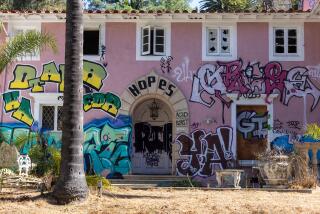A House on the Hill : The Creator of ‘Dallas’ Builds a Home Beneath the Hollywood Sign
- Share via
This house is as Hollywood as they come. Situated high on a hilltop near the Hollywood sign, it belongs to TV producer David Jacobs--creator of “Dallas” and “Knots Landing”--and his wife, Diana.
Like so many of their colleagues, the Jacobs could have built their home in Beverly Hills or Malibu. Instead, they chose to make their primary home on a ridge near the famous sign. And in order to do so, they purchased two adjacent lots--one virtually inaccessible and the other with a private drive.
Designed by architect Michael Pearce, of Michael Pearce + Associates, Westwood, and Richard Clemenson, the 4,000-square foot, three-story stucco house has four bedrooms and six bathrooms. David’s studio is on the upper level; the entertaining and living areas are on the central level, and the lower level contains the bedrooms. The interior and exterior color schemes--which range from mauve, peach and lavender to blue-green--were created by Helen Walker.
From the hillside, a unique geometry is visible. Rounded walls, balconies and an overhang that face the sign “appear to have the contour of a television screen, which seems to be appropriate for my clients,” Pearce says. Beyond the sign the Jacobs have a 270-degree view that extends from downtown Los Angeles to the Pacific Ocean and beyond. A large number of windows and French doors on all levels fills the house with light.
Another view of the house reveals the 50-foot-long pool that runs the length of the house, wrapping around the second floor. The most unusual feature of the Jacobs’ home is an 18-foot-long underwater window (made from one sheet of 2 1/2-inch-thick acrylic) that looks out into the pool from the master suite.
“This house is highly detailed,” Pearce says. “It has many custom features: bleached-oak floors, Vermont-slate floors, green Athenian-marble countertops in the baths and kitchen, custom-made and custom-colored railings, custom-designed furniture.” Pearce designed some of the furniture himself, using post-modern forms in colors chosen from Walker’s color palette.


